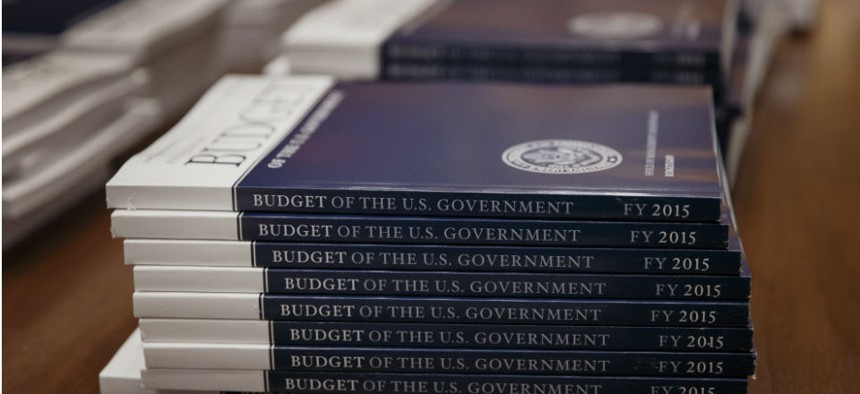
Obama's fiscal 2015 budget did not ask federal employees to contribute more toward their retirement, but it did propose 136 program cuts and consolidations. J. Scott Applewhite/AP
Obama’s Budget Will Soar Way Above Sequestration Spending Caps
White House looks to unwind three-year-old measure that has crippled agencies’ budgets.
President Obama will seek to reverse the spending caps created by sequestration in his fiscal 2016 budget, according to a White House official, proposing to spend roughly $74 billion more than the current statutory limits.
Overall, Obama will propose raising spending levels about 7 percent higher than those spelled out in the 2011 Budget Control Act. About half of the increase would go toward Defense spending, while the other half would boost funding for non-Defense federal agencies.
The White House will formally release Obama’s budget Monday, but he will outline his intentions to “reverse harmful sequestration cuts” Thursday night in a speech to the House Democratic Caucus in Philadelphia, the official said.
“As we make these investments in our future, the president will propose to end the across-the-board sequester cuts that threaten our economy and our military,” the official added. “The president’s budget will fully reverse those cuts for domestic priorities, and match those investments dollar-for-dollar with the resources our troops need to keep America safe.”
Cutting spending to its lowest level since 2007 has forced “arbitrary budget cuts,” the official said, adding Obama wants to “end the era of manufactured crises and mindless austerity.”
Congress provided for a partial reprieve from sequestration in fiscal years 2014 and 2015 with the passage of the 2013 Bipartisan Budget Act, but the full effect of the Budget Control Act is set to kick back in for fiscal 2016. If Congress declines to lift those caps, non-defense discretionary funding would be cut off at $493 billion, while Defense spending would not exceed $523 billion. Under Obama’s proposal, those figures would jump to about $530 billion and $561 billion, respectively.
A dramatic funding increase would come as welcome news for federal agencies that have been dealing with reduced spending levels since 2013. Obama’s proposals, however, are likely to run into significant resistance from Republicans, who now control both chambers of Congress and are still concerned about the size of the federal debt.
“The past will catch up to us no matter how fast we run from it,” said Sen. Mike Enzi, R-Wyo., chairman of the Senate Budget Committee, earlier this week. “The Congressional Budget Office’s new figures show our failure to root out wasteful spending and live within our means. This has left us with an endless supply of debt that grows larger by the day.”
The inevitable spending fight will put agencies in the difficult position of contingency planning for two vastly different budget scenarios. Should Congress fail to pass a budget blueprint that offsets sequestration cuts, spending levels will automatically reset back to the BCA caps. Agencies would be left scrambling to determine where and how to cut, much like in 2013 when the White House directed agencies not to plan for sequestration cuts it assumed Congress would stave off. Unlike in 2013, however, Congress now has more flexibility in implementing the cuts and agencies should -- theoretically -- have more time to prepare.
Obama’s budget blueprint would likely allow agencies to resume more regular hiring and training, both of which have been cut back significantly over the last several years. While the White House has, for the most part, not disclosed the specifics of the forthcoming budget plan, the funding boost also makes proposals for deficit reduction on the backs of federal employees less likely.
Obama has previously used his budget to suggest federal employees contribute more toward their retirement benefits and to recommend a less generous formula to calculate cost-of-living adjustments for federal retirees. Those proposals were absent from his fiscal 2015 budget, though he did put forward 136 different cuts and consolidations -- including workforce reductions at several agencies -- and $2 billion in savings from the Federal Employees Health Benefits Program through modernization and efficiency efforts.
Agencies would not be fully shielded from cutbacks under Obama’s fiscal 2016 plan; the president said in a Huffington Post op-ed Thursday his funding boost would be paid for mostly through closing tax loopholes, but also by “cutting inefficient spending.”
That rhetoric, however, is unlikely to assuage the concerns of Obama’s Republican opposition. House Budget Committee Chairman Tom Price, R-Ga., said at a hearing this week revenue is not the issue.
“It's a spending problem,” Price said, “and for all that has been said about the recent decrease in annual deficits, we have not solved our nation’s fiscal challenges.”







